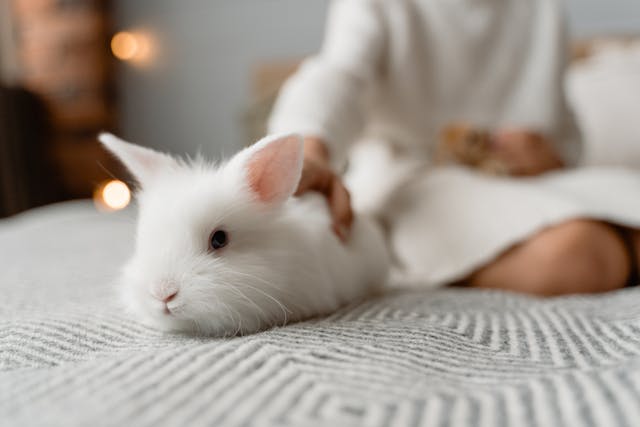Simple Ways to Clean a Rabbit: A Complete Guide for Pet Owners
Rabbits are known to be adorable, gentle, and clean animals kept as pets or for business purposes. On the other hand, like any pet, there are times when your rabbits may need a little help to stay clean from dirt. Whether it’s due to accidental messes, shedding, or medical needs, understanding how to clean a rabbit is essential for keeping them healthy.
This post will guide you about safe, simple, and effective ways to clean a rabbit, ensuring you provide the best care without causing stress or harming it in any way.
Is It Safe to Bathe a Rabbit?
Before going into details of the cleaning methods, it’s necessary to address some common questions: Can rabbits be bathed like cats or dogs?
The answer to this question is no. Rabbit skin is known to be very delicate and is prone to stress, which can even lead to serious health issues if submerged in water. Full-body baths of rabbits are rarely recommended and are often discouraged unless advised by your veterinarian.
Instead, focus on spot cleaning, dry baths, and proper grooming, which are safer and more comfortable for rabbits.
Essential Supplies for Cleaning a Rabbit
Before starting the cleaning process, gather the following supplies:
- Soft towels
- Baby wipes (unscented, alcohol-free, pet-safe)
- Cornstarch-based baby powder (no talc)
- Fine-tooth comb or flea comb
- Soft bristle brush
- Small scissors (for mats)
- Litter box with fresh litter
- Clean, lukewarm water in a bowl (optional for spot cleaning)
- Rabbit-safe shampoo (only if recommended by a vet)
1. Spot Cleaning: The Safest Way to Clean a Rabbit
When your rabbit gets a little dirty, whether from food stains, urine, or droppings, spot cleaning is the most recommended method.
Steps:
- Place your rabbit on a soft towel or non-slip surface.
- Dip a soft cloth or cotton ball in lukewarm water.
- Gently wipe the soiled area without soaking the fur.
- Use an alcohol-free, unscented baby wipe for stubborn spots.
- Pat the cleaned area dry with a towel.
- Keep the rabbit in a warm, draft-free area until fully dry.
Tip: Never use hot water, and avoid getting water into the ears, eyes, or nose.
2. Dry Bath Method: Great for Mild Dirt and Odor
If your rabbit’s fur feels greasy or slightly dirty, a dry bath can be a better option.
Steps:
- Sprinkle a small amount of cornstarch-based baby powder onto the dirty area.
- Gently rub the powder into the fur with your fingers.
- Use a soft brush or comb to remove the powder along with dirt and debris.
- Be careful not to inhale the powder or let it get into the rabbit’s nose or eyes.
This method is effective for removing excess oils and minor dirt without the stress of water.
3. Cleaning a Rabbit’s Bottom: Essential for Hygiene
Sometimes rabbits suffer from a condition called “poopy butt”, where feces get stuck to their fur, usually due to diet or health issues. To avoid these actions and health complications, you must get them better diet.
Steps to follow:
- Fill a shallow bowl with lukewarm water (just enough to dip the bottom).
- Gently lower the rabbit’s rear into the water, keeping the rest of the body dry.
- Soften the feces with your hands or a soft cloth.
- Use mild, rabbit-safe shampoo if needed (consult a vet).
- Rinse thoroughly and gently.
- Dry with a towel and then a blow dryer on the lowest, coolest setting—make sure the noise doesn’t stress the rabbit.
Preventive Tip:
- Feed a balanced diet high in hay and fiber to reduce digestive issues.
4. Brushing and Grooming: The Easiest Cleaning Routine
Rabbits shed regularly, and long-haired breeds like Angoras need extra grooming.
What to do:
- Use a soft-bristle brush for daily grooming.
- A flea comb works well for removing loose fur during shedding seasons.
- Trim mats carefully with scissors, especially behind the legs and under the belly.
- Check for ticks, fleas, or skin conditions while brushing.
Brushing not only keeps your rabbit clean but also prevents dangerous fur blockages when they groom themselves.
5. Cleaning Ears, Eyes, and Face Gently
- Ears: Wipe the outer ear with a damp cloth. For wax buildup or mites, consult a vet.
- Eyes: Use a cotton pad with warm water to clean tear stains or debris gently.
- Face: A damp cloth or an unscented wipe works for removing food stains.
6. Litter Box Cleaning: Prevent Dirt Before It Starts
A clean litter box means a cleaner rabbit.
Best Practices for Rabbit Cleaning:
- Scoop the litter daily.
- Change litter completely 2-3 times a week.
- Wash the box with mild soap and water weekly.
- Use absorbent, dust-free litter like paper pellets or aspen shavings.
A clean environment reduces the chances of your rabbit getting dirty in the first place.
7. When to Seek Professional Help
- If your rabbit has mats that you cannot untangle.
- Persistent odor despite cleaning.
- Signs of skin infections, wounds, or parasites.
- Difficulty moving or grooming themselves.
In such cases, contact a vet or a professional rabbit groomer.
Conclusion
Keeping Your Rabbit Clean and Healthy
Cleaning a rabbit doesn’t have to be stressful for you or your pet. By practicing spot cleaning, dry baths, regular grooming, and maintaining a clean environment, you ensure your bunny stays happy, healthy, and hygienic.
Remember, the best way to avoid frequent cleaning is through preventive care—balanced nutrition, regular litter changes, and daily grooming. Avoid full-body baths unless under strict veterinary advice, as it can cause stress or even hypothermia in rabbits.
Read More: The Ultimate Guide About Lionhead Rabbits


1 Comment
Pingback: How to Clean a Rabbit Litter Box – Complete Guide (Expert’s Tip) -